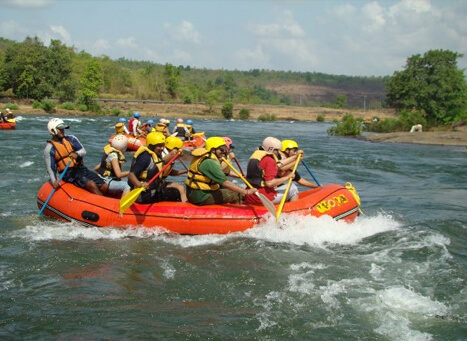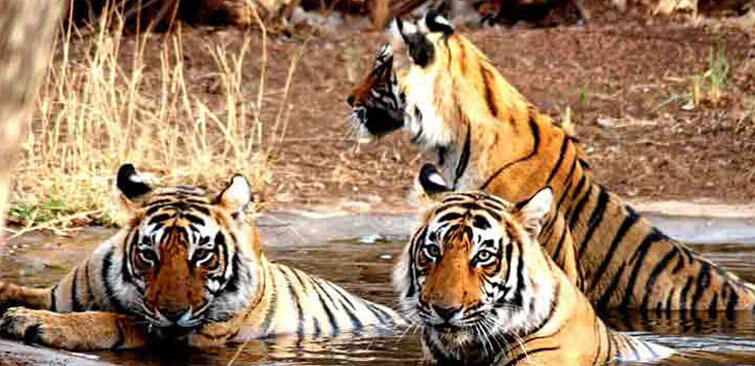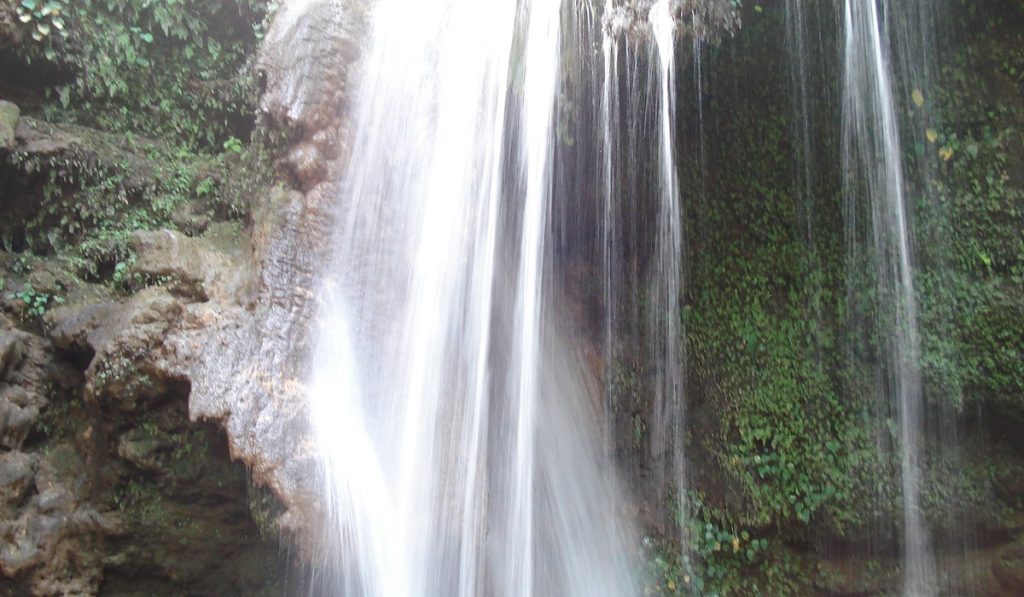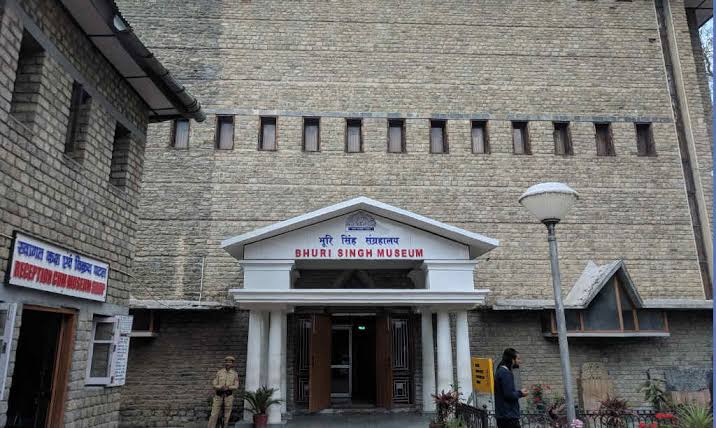Leopards are thriving in Karnataka. Their population is on the rise.
This is exciting news for wildlife enthusiasts and conservationists alike. Karnataka, known for its rich biodiversity, has seen a significant increase in leopard numbers. This positive trend highlights successful conservation efforts and the state’s commitment to preserving its natural heritage.
Leopards play a crucial role in maintaining ecological balance, and their growing numbers are a testament to the health of the ecosystem. Discover how these majestic creatures are making a comeback and what it means for the future of wildlife in Karnataka. Join us as we explore the factors contributing to this remarkable resurgence and its impact on the region’s biodiversity.
Leopard Population Surge
Leopard numbers in Karnataka have shown a significant rise recently. This increase highlights successful conservation efforts in the region.
Leopard Population Surge Leopards, the elusive and majestic big cats, have been making a remarkable comeback in Karnataka. Recent data reveals a significant increase in their population. This surge is a beacon of hope for wildlife enthusiasts and conservationists alike. But what does this mean for Karnataka’s biodiversity and the challenges of human-wildlife coexistence?Recent Census Data
The latest census data has painted a promising picture for the leopards in Karnataka. According to the 2023 wildlife census, the leopard population in Karnataka has increased by 30% over the past five years. This is a considerable jump from the previous count, indicating effective conservation efforts. Table: Leopard Population Over the Years| Year | Leopard Population |
|---|---|
| 2018 | 1,500 |
| 2023 | 1,950 |
Comparative Analysis
When comparing this data to other regions in India, Karnataka stands out. Neighboring states like Tamil Nadu and Kerala have not seen such a significant rise in leopard populations. Karnataka’s strategies could serve as a model for others. Key Factors for Success: – Habitat Conservation: Karnataka has invested in preserving and expanding natural habitats. This has provided leopards with safe areas to thrive. – Anti-Poaching Measures: Increased patrolling and stricter laws have contributed to reducing poaching incidents. – Community Involvement: Local communities are now more involved in conservation efforts. They participate in awareness programs and report any illegal activities. You might wonder why this matters to you. The increased leopard population indicates a healthier ecosystem. Leopards are apex predators, and their presence ensures the balance of the food chain. This, in turn, benefits other wildlife and even the vegetation, affecting everything from the air you breathe to the water you drink. Challenges Ahead: With this positive trend, new challenges arise. How do we maintain this growth while ensuring human-wildlife conflict does not escalate? Leopards often venture into human territories, leading to conflicts. Innovative solutions like building wildlife corridors and implementing better waste management can reduce such encounters. What Can You Do? – Stay Informed: Awareness is the first step towards involvement. Keep updated with local wildlife news and reports. – Support Conservation Efforts: You can contribute to NGOs working towards wildlife conservation. – Promote Coexistence: If you live near leopard habitats, follow guidelines to minimize conflict. Secure your livestock and avoid leaving food waste accessible. The increase in the leopard population in Karnataka is a testament to what dedicated efforts can achieve. As we celebrate this success, let’s also think about how we can continue to support and sustain this growth. What steps will you take to contribute to this cause? Your engagement can make a difference. Together, we can ensure that the leopards of Karnataka continue to thrive and roam freely in their natural habitats.
Credit: www.downtoearth.org.in
Conservation Efforts
Conservation efforts have played a vital role in increasing the leopard population in Karnataka. Various strategies have been implemented to protect these majestic creatures and their habitats. The collaboration between government bodies and NGOs has led to remarkable progress.
Government Initiatives
The Karnataka government has launched several initiatives to conserve leopards. One major step is the establishment of protected areas. These zones provide a safe environment for leopards to thrive. Strict regulations prevent illegal hunting and poaching. Forest officials conduct regular patrols to ensure safety.
Awareness campaigns educate the public about the importance of leopard conservation. Schools and communities receive information on how to coexist with wildlife. The government also invests in research to monitor leopard populations. Data collected helps in making informed decisions for their protection.
Ngo Contributions
Non-Governmental Organizations (NGOs) significantly contribute to leopard conservation in Karnataka. They work closely with local communities to reduce human-wildlife conflicts. Training sessions teach villagers methods to protect their livestock without harming leopards. This reduces retaliation against the animals.
NGOs also participate in rescue operations for injured or trapped leopards. They provide medical care and rehabilitation. Many NGOs focus on habitat restoration projects. These initiatives ensure leopards have ample space and resources to survive. Collaboration with scientists and conservationists enhances their efforts.
Habitat Restoration
Restoring the natural habitat is crucial for the resurgence of the leopard population in Karnataka. Habitat restoration involves a series of strategic actions aimed at reviving the ecosystems that these majestic creatures depend on. By focusing on forest regeneration and water source revival, we can create a thriving environment for leopards and other wildlife. Let’s delve into these vital components.
Forest Regeneration
Imagine walking through a lush forest, teeming with life. This vision is becoming a reality in Karnataka thanks to dedicated forest regeneration efforts. Authorities and local communities are working together to replant native trees, remove invasive species, and protect existing flora. These activities help create a more diverse and sustainable habitat.
- Native tree planting: Planting species that are indigenous to the region supports the local ecosystem and provides leopards with natural cover and hunting grounds.
- Invasive species removal: Eradicating plants that disrupt the balance of the ecosystem allows native species to thrive.
- Community involvement: Local participation in these efforts fosters a sense of ownership and encourages sustainable practices.
Have you ever volunteered for a tree-planting drive? If not, consider joining one. Your contribution can make a significant difference. Every tree planted is a step towards a healthier forest and a safer home for leopards.
Water Source Revival
Water is life. Reviving water sources is essential for the survival of leopards and other wildlife. In Karnataka, efforts are underway to rejuvenate dried-up rivers, lakes, and ponds. These initiatives not only provide drinking water but also create thriving ecosystems.
- River rejuvenation: Cleaning and desilting riverbeds to restore natural water flow.
- Pond and lake revival: Restoring these bodies of water ensures a reliable water source during dry seasons.
- Rainwater harvesting: Implementing structures to capture and store rainwater for future use.
Think about it—how often do you take water for granted? By supporting water revival projects, you help ensure that wildlife, including leopards, has access to this precious resource. Next time you see a rainwater harvesting system, understand its vital role in preserving our natural world.
Habitat restoration in Karnataka is a beacon of hope for leopard conservation. Forest regeneration and water source revival are two powerful strategies that promise a brighter future for these beautiful creatures. Your involvement, whether through volunteering or spreading awareness, can help sustain these efforts. So, what steps will you take to support habitat restoration in your community?

Credit: www.facebook.com
Community Involvement
Community involvement has played a crucial role in the increase of the leopard population in Karnataka. By engaging local communities, various initiatives have been implemented to ensure the safety and growth of these magnificent creatures. This collaborative effort has fostered a sense of responsibility and awareness among the residents, leading to positive changes in leopard conservation.
Local Awareness Programs
Local awareness programs have been pivotal in educating people about leopards. These programs include workshops and seminars led by wildlife experts. They teach people about leopard behavior and how to stay safe. Schools also participate by organizing educational trips to wildlife reserves. This helps students understand the importance of leopards in the ecosystem. Informative brochures and posters are distributed in villages. These materials highlight the need for leopard conservation and provide safety tips.
Human-wildlife Coexistence
Promoting human-wildlife coexistence is essential for sustainable conservation. Farmers are encouraged to use non-lethal methods to protect their livestock. This reduces conflicts between humans and leopards. Community members are trained to identify and report leopard sightings. This helps wildlife authorities take timely action to prevent accidents. Villages near leopard habitats have implemented measures to secure their homes and livestock sheds. Proper waste management practices are promoted to avoid attracting leopards to human settlements. These efforts ensure a harmonious relationship between humans and leopards.
Anti-poaching Measures
In Karnataka, the increase in the leopard population is a remarkable achievement. This success is largely due to comprehensive anti-poaching measures. These measures play a crucial role in protecting these magnificent animals from illegal hunting. Let’s delve into the various techniques and strategies that have been implemented to curb poaching and ensure the safety of leopards.
Surveillance Techniques
Surveillance is a cornerstone in the fight against poaching. Advanced technology has revolutionized how wildlife is monitored. For instance, the use of camera traps has proven highly effective. These cameras are strategically placed in forests and are triggered by motion, capturing images of any moving object. This helps in monitoring leopard movements and identifying potential poachers.
Moreover, drones are now being employed to patrol vast areas. Drones can cover larger territories quickly and are equipped with night vision to detect activities during the night. This aerial surveillance ensures that any suspicious activities are immediately reported to forest officials.
Have you ever wondered how these technologies are operated? Trained personnel are crucial. Dedicated teams work round the clock, analyzing data from these devices to ensure timely interventions. This human touch, combined with technology, creates a robust surveillance system.
Legal Framework
A strong legal framework is essential to deter poaching. Karnataka has enforced stringent laws to protect wildlife. The Wildlife Protection Act is the primary legislation that governs the conservation of wildlife. It includes severe penalties for those caught poaching, ranging from hefty fines to long-term imprisonment.
Additionally, special courts have been established to expedite the trial of wildlife-related offenses. This ensures that justice is swift and serves as a powerful deterrent to potential poachers. Moreover, the involvement of local communities in conservation efforts has been encouraged through legal provisions that recognize their rights and roles in protecting wildlife.
Do you think laws alone can stop poaching? Enforcement is key. Regular patrols by forest guards, along with surprise checks, help in the implementation of these laws. Collaborative efforts between law enforcement agencies and wildlife organizations also enhance the effectiveness of these legal measures.
These anti-poaching measures—surveillance techniques and a strong legal framework—are crucial in ensuring the safety and growth of the leopard population in Karnataka. With continued efforts and community involvement, we can hope to see these majestic animals thrive for generations to come.
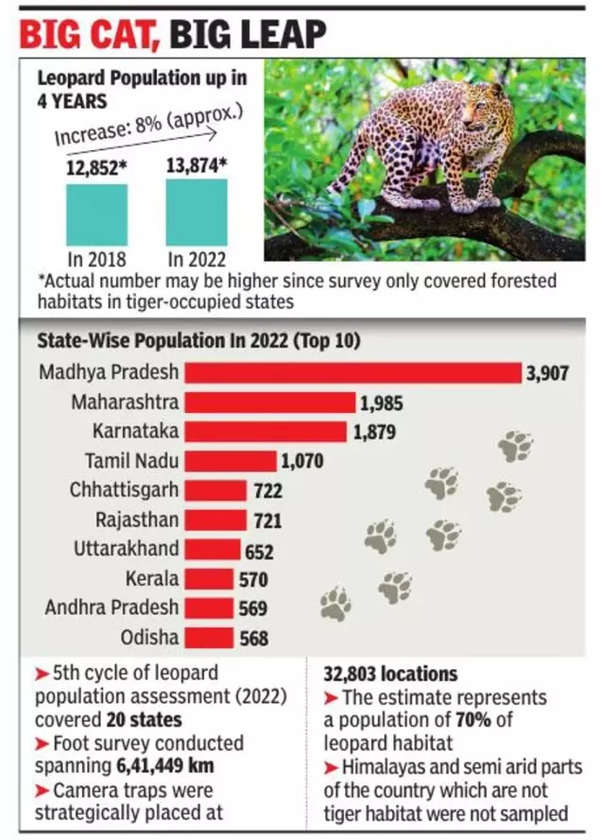
Credit: timesofindia.indiatimes.com
Technological Advancements
The rise in leopard population in Karnataka can be attributed to technological advancements. These innovations have made tracking and monitoring leopards more efficient. They have also improved data analysis, leading to better conservation strategies. Let’s explore these advancements in detail.
Tracking And Monitoring
Tracking leopards is crucial for understanding their behavior and habitat. Modern GPS collars help in real-time tracking. These collars send location data to researchers. This helps in monitoring leopard movements and habits.
Camera traps are another essential tool. They capture images of leopards in their natural habitat. These images provide insights into population density and health. They also help in identifying individual leopards.
Data Analysis Tools
Data collected from tracking devices is vast. Advanced data analysis tools help in managing this data. Software programs analyze patterns and trends. This helps researchers make informed decisions.
GIS (Geographic Information Systems) is one such tool. It maps leopard habitats and their changes over time. This helps in identifying critical areas for conservation. Machine learning algorithms also play a role. They predict future movements and potential threats.
These technological advancements are crucial. They ensure the survival and growth of the leopard population in Karnataka.
Challenges Ahead
Leopard population in Karnataka is on the rise. Managing human-wildlife conflict and habitat conservation now pose significant challenges.
Leopard populations are on the rise in Karnataka. This is great news for wildlife enthusiasts and conservationists. However, this increase comes with its own set of challenges. These challenges must be addressed to ensure that both leopards and humans can coexist peacefully. Let’s delve into some of the key issues that need our attention. ### Human Encroachment Human encroachment is one of the biggest challenges to leopard conservation. As cities and towns expand, natural habitats shrink. Leopards, driven by the need for food and shelter, often venture into human settlements. This can lead to unfortunate encounters. Imagine waking up one morning to find a leopard in your backyard. It’s a frightening thought, isn’t it? This is the reality for many people living on the edges of forests. Such encounters not only pose a threat to human safety but also result in leopards being captured or killed. To tackle this, we need better urban planning that respects wildlife corridors. Communities should be educated on how to coexist with leopards. Simple measures like securing livestock and proper waste management can reduce the chances of leopards straying into human areas. ### Climate Change Impact Climate change is another significant challenge affecting leopard populations. Rising temperatures and changing rainfall patterns disrupt the delicate balance of ecosystems. This impacts the availability of prey and water sources for leopards. When I visited Bandipur National Park last summer, the forest seemed drier than usual. The guides mentioned that waterholes were drying up faster than before. This forces leopards and other wildlife to move further in search of water, increasing the chances of human-wildlife conflict. How can you contribute to mitigating these impacts? Reducing your carbon footprint is a start. Support policies aimed at combating climate change. Spread awareness about the importance of preserving natural habitats. In tackling both human encroachment and climate change, we can create a safer environment for leopards and humans alike. The rise in leopard populations in Karnataka is a positive sign, but it comes with responsibilities. By addressing these challenges head-on, we can ensure a harmonious coexistence with these majestic creatures.Future Prospects
Karnataka has witnessed a promising increase in its leopard population. Conservation efforts and habitat protection have contributed significantly to this positive trend. The future looks bright for these majestic big cats in the region.
Leopard Population Increases In Karnataka: Future Prospects The recent surge in the leopard population in Karnataka is a testament to the state’s commitment to wildlife conservation. As we look to the future, it’s crucial to explore how we can sustain this growth and expand conservation efforts. This is not just about numbers; it’s about creating a harmonious environment where leopards and humans can coexist peacefully.Sustaining The Growth
One of the key elements to sustaining the leopard population in Karnataka is maintaining their natural habitats. Leopards need vast, undisturbed areas to thrive. You can help by supporting local conservation initiatives and spreading awareness about the importance of preserving these spaces. Effective anti-poaching measures are also essential. Local authorities have ramped up efforts, but your vigilance can make a difference. Report any suspicious activities and educate others about the consequences of poaching. Human-leopard conflict is another challenge. You might have heard stories of leopards wandering into villages. It’s vital to implement and support measures that prevent such encounters. Simple actions like securing livestock and installing proper fencing can reduce these incidents significantly.Expanding Conservation Areas
To ensure a stable future for leopards, expanding conservation areas is critical. Karnataka has several wildlife sanctuaries, but expanding these protected zones can provide leopards with more room to roam. Imagine a network of interconnected habitats stretching across the state. This vision can become a reality with your support. Collaborative efforts between the government, NGOs, and local communities are the way forward. These partnerships can lead to the creation of new conservation areas. How can you contribute? Participate in community meetings, support policies that favor wildlife conservation, and volunteer with organizations dedicated to this cause. Moreover, technology can play a pivotal role. Drones and camera traps can monitor leopard movements and ensure they are safe. If you’re tech-savvy, consider joining or supporting initiatives that employ these advanced tools. Are you ready to be part of this journey? Every small action counts towards securing a future where leopards continue to thrive in Karnataka. Let’s work together to make it happen.Frequently Asked Questions
How Many Leopards Are There In Karnataka?
As of the latest survey, Karnataka is home to approximately 2,500 leopards. The population is spread across various forests and reserves.
Which State Has The Highest Leopard Population In India?
Madhya Pradesh has the highest leopard population in India. The state’s diverse habitats support a thriving leopard community.
Is Leopard Population Increasing?
Leopard populations are generally declining due to habitat loss and poaching. Some regions report stable or slightly increasing numbers through conservation efforts.
Which Animal Is Highest In Karnataka?
The highest animal in Karnataka is the Indian elephant. These elephants are mainly found in the forests of the Western Ghats.
Conclusion
The increase in Karnataka’s leopard population is a positive sign. It shows successful conservation efforts. Local communities have played a crucial role too. Protecting these majestic animals is essential. Future generations deserve to see leopards in the wild. Continued efforts will ensure their safety.
Preserving their habitat is key. Karnataka sets a great example for wildlife conservation. Together, we can make a difference. Let’s keep supporting these vital initiatives. Every action counts.
{ “@context”: “https://schema.org”, “@type”: “FAQPage”, “mainEntity”: [ { “@type”: “Question”, “name”: “How many leopards are there in Karnataka?”, “acceptedAnswer”: { “@type”: “Answer”, “text”: “As of the latest survey, Karnataka is home to approximately 2,500 leopards. The population is spread across various forests and reserves.” } } , { “@type”: “Question”, “name”: “Which state has the highest leopard population in India?”, “acceptedAnswer”: { “@type”: “Answer”, “text”: “Madhya Pradesh has the highest leopard population in India. The state’s diverse habitats support a thriving leopard community.” } } , { “@type”: “Question”, “name”: “Is leopard population increasing?”, “acceptedAnswer”: { “@type”: “Answer”, “text”: “Leopard populations are generally declining due to habitat loss and poaching. Some regions report stable or slightly increasing numbers through conservation efforts.” } } , { “@type”: “Question”, “name”: “Which animal is highest in Karnataka?”, “acceptedAnswer”: { “@type”: “Answer”, “text”: “The highest animal in Karnataka is the Indian elephant. These elephants are mainly found in the forests of the Western Ghats.” } } ] }
